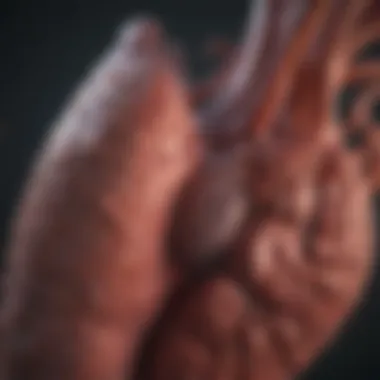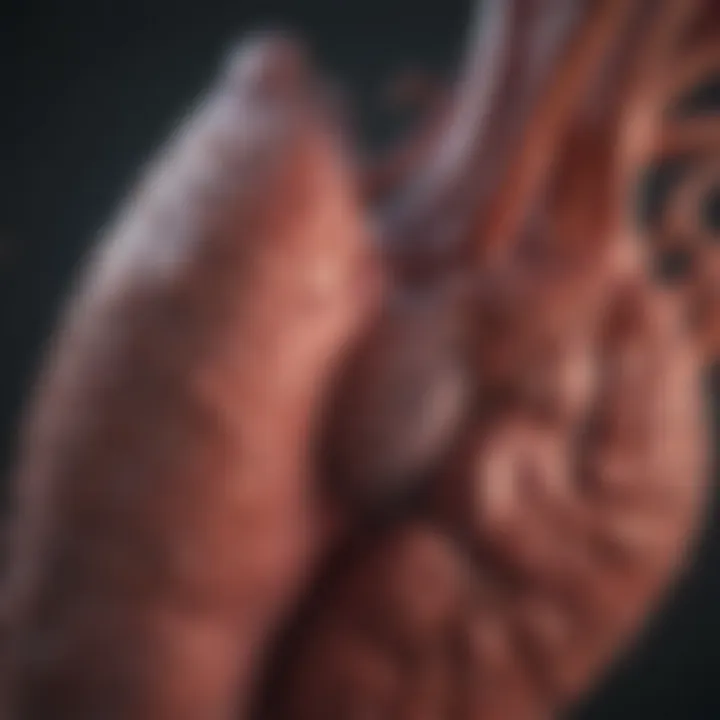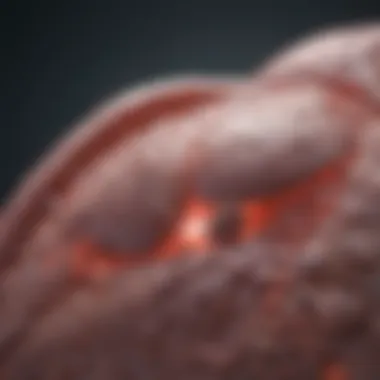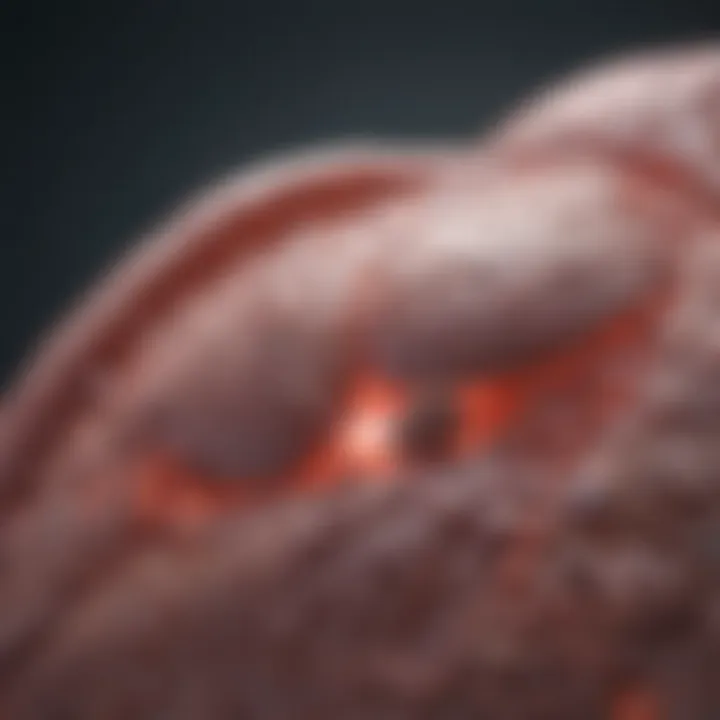Understanding the Final Stages of Liver Cancer


Intro
Liver cancer is often viewed as an insidious disease, creeping into the lives of patients, altering the course of their health. As the disease progresses toward its end stages, a profound transformation occurs – not just within the liver itself but impacting the patient's entire body, mind, and spirit.
This phase is like an unwelcome party guest that doesn’t know when to leave. It brings with it a cacophony of symptoms and challenges, leaving patients and caregivers grappling with difficult realities. Understanding these complexities becomes a vital undertaking, as it not only sheds light on clinical manifestations but also illuminates the human experience behind the medical data.
Most notably, the end stages are characterized by severe liver dysfunction, which manifests through a variety of signs and symptoms, such as jaundice, abdominal swelling, and profound fatigue. The psychological burden of facing terminal illness adds layers of complexity in coping and care decisions.
Clinical decision-making during this period demands a nuanced approach, as treatment options become limited, shifting the focus toward palliative care. This care focuses more on quality of life and symptom management than on curative intent.
In the sections that follow, we will delve deeper into the clinical aspects of end-stage liver cancer, explore therapeutic possibilities, and examine the crucial role of caregivers and healthcare providers. The aim is to weave a narrative that not only informs but also empathizes with those affected by this grave condition.
Prelims to Liver Cancer
Liver cancer is a significant health issue, not just due to its complexity but also because of its rising incidence worldwide. The liver, a crucial organ in the body, plays a vital role in metabolism, detoxification, and the production of vital proteins. Understanding liver cancer thus demands a closer look at its anatomy along with the various types and stages it entails. Recognizing the importance of this topic establishes a foundation for further exploration of the end stages of this disease.
This article sheds light on the intricacies surrounding liver cancer while serving as a guide to both patients and caregivers navigating through advanced stages. It presents essential aspects that include clinical manifestations, diagnostic approaches, and available treatment options. Diving into the anatomy of the liver also keeps us informed about how this organ functions, aiding in comprehending how cancer disrupts its various processes.
By equipping readers with the knowledge of specific liver cancer types, like Hepatocellular Carcinoma, Cholangiocarcinoma, and Metastatic Liver Cancer, one can appreciate the variances in behavior and treatment approaches. Additionally, understanding epidemiological trends can be a game-changer for research and public health initiatives aimed at reducing incidence rates. This foundational knowledge prepares readers for a comprehensive understanding of the challenges posed by liver cancer, particularly in its later stages.
"Knowledge is power, especially when it comes to understanding how our body works and responding to disease."
The insights gained from this discussion are not only beneficial for healthcare professionals but also for students and researchers eager to delve deeper into liver cancer management. In grasping the critical elements of liver cancer, we pave the way for more informed discussions about the experience of patients and the responsibilities of caregivers in dealing with end-stage scenarios.
Stages of Liver Cancer
Understanding the stages of liver cancer is crucial for a variety of reasons, especially when it comes to treatment decisions and patient quality of life. Each stage reveals specific details about the extent of the disease and can significantly alter the approach to management. By accurately identifying the stage, healthcare providers can better align therapies with patient needs, thus facilitating a more personalized and effective treatment journey. Moreover, recognizing the signs of progression helps caregivers and families prepare for what lies ahead and enables timely interventions.
Overview of Staging Systems
When discussing liver cancer, two primary staging systems come into play: the Barcelona Clinic Liver Cancer (BCLC) system and the TNM classification. These systems not only categorize cancer stages but also provide a framework for clinical decision-making.
Barcelona Clinic Liver Cancer (BCLC)
The BCLC staging system is widely recognized for its holistic approach, which considers both the tumor's biology and the patient's overall health. One of its key characteristics is its incorporation of performance status and liver function, making it particularly beneficial in guiding treatment options.
A unique feature of BCLC is its stratification of treatment modalities based on early, intermediate, advanced, and end-stage cancer. For instance, patients diagnosed with early-stage liver cancer may qualify for curative treatments like surgery or ablation, whereas advanced stages might necessitate palliative care options. This tailored approach addresses individual patient circumstances, thereby potentially improving outcomes.
However, despite its advantages, BCLC is not without limitations. It may be less effective for patients with multifocal disease or those who do not fit neatly into its categories, which could restrict access to appropriate treatments.
TNM Classification
On the other hand, the TNM classification offers a more traditional anatomical classification of tumors based on Tumor size, Node involvement, and Metastasis. This system is perhaps more universally recognized, providing clarity across different cancer types, including liver cancer. The key characteristic of TNM is its simplicity in quantifying disease spread and its standardized language, which eases communication among healthcare providers.
One unique aspect of TNM classification is its ability to indicate regional lymph node involvement and distant metastasis effectively. This capability adds an important dimension in assessing the aggressiveness of the cancer and can be critical for surgical planning. However, the downsides of TNM include its focus primarily on anatomical features, which may overlook essential factors like liver function that BCLC considers.
Early to Middle Stages
As liver cancer progresses from early to middle stages, several changes become noticeable. In the early stages, we might see small tumors mainly contained within the liver, often without significant symptoms. Symptoms can be vague, sometimes resembling organ fatigue or digestive discomfort.
By the time patients find themselves in the middle stages, the complexities of their condition typically increase. Tumors may grow larger or develop into multiple sites within the liver. At this point, patients may start exhibiting more distressing signs, such as noticeable weight loss, a decrease in appetite, or even mild jaundice. Regular monitoring becomes increasingly essential, as the decisions made during this stage can have long-term implications.
Transition to End Stages
Transitioning from middle to end stages is often marked by rapid deterioration in health and quality of life. The body exhibits signs of organ failure, and the symptoms can become severely debilitating. Patients may face intense fatigue, ascites, and significant jaundice. Moreover, advanced liver cancer leads to a cascading effect, often impacting other organs and systems. Palliative care becomes the primary focus during this transition, as the emphasis shifts from curative efforts to managing symptoms and providing comfort. This shift can be emotionally challenging for patients and their families, necessitating robust support networks to navigate the psychological aspects of advanced disease management.
Clinical Manifestations of End-Stage Liver Cancer
Understanding the clinical manifestations of end-stage liver cancer is crucial for tailoring care and improving quality of life for patients. This stage signifies not just the progression of cancer, but also a considerable shift in how the body functions due to liver failure. The effects of this illness extend beyond the physiological, impacting emotional andmental well-being as well.
In this article, we cover the most significant symptoms that arise during this critical phase, including jaundice, ascites, and fatigue. It's essential to note that just as each individual copes differently with their diagnosis, their experiences with these symptoms can vary widely. Recognizing the symptoms helps healthcare professionals to plan appropriate interventions and provide palliative care, ensuring that patients can maintain dignity and comfort in their final days.
Symptoms and Signs
Jaundice
Jaundice, marked by a yellowing of the skin and eyes, emerges as a defining hallmark of end-stage liver cancer. This characteristic occurs when the liver fails to filter bilirubin from the bloodstream effectively. The presence of jaundice is not just visually distressing—it serves as an indicator of liver function decline. This symptom's clarity makes it a focused point of discussion, emphasizing the urgency for management and support.
Unique features of jaundice include:
- Its direct correlation with liver dysfunction
- Varied severity depending on the extent of liver failure


However, it can be nuanced; while jaundice alerts caregivers, it also signifies increased discomfort for the patient, adding layers to their emotional state.
Ascites
Ascites, or fluid accumulation in the abdominal cavity, frequently accompanies advanced liver disease. As portal hypertension intensifies due to liver damage, the body’s ability to manage fluid balance deteriorates, leading to this uncomfortable condition. Patients often describe this sensation as heaviness or pressure in the abdomen, which not only limits mobility but can cause distress.
Ascites presents unique characteristics:
- It can be assessed through physical examination or imaging, offering a tangible metric of disease progression
- The amount of fluid can vary greatly from one individual to another
This variability can indicate both the patient's overall health and the effectiveness of treatment options, providing healthcare teams with a critical understanding of modifications needed in care strategies.
Fatigue
Fatigue in end-stage liver cancer presents itself as profound tiredness that defies simple explanations. This symptom is often overlooked yet deeply impacts a patient's daily life. The fatigue results from multiple factors, including metabolic changes and the body's struggle to cope with cancer. It impacts not just the physical realm but extends into emotional well-being, creating challenges in maintaining social interactions and day-to-day tasks.
Points of interest regarding fatigue include:
- It can lead to a cycle of reduced activity, further exacerbating feelings of weakness
- Fatigue may not improve significantly with rest, complicating communication about the patient's actual condition
Understanding fatigue is essential for caregivers and healthcare providers as they strive to facilitate meaningful connections and supportive environments.
Complications Arising in Advanced Disease
Complications from liver cancer don’t simply complicate the clinical picture—they can radically change a person’s experience of illness. As we delve deeper into complications like hepatic encephalopathy and portal hypertension, it’s paramount to recognize how these conditions manifest in practical terms for patients and those around them. Each complication comes with its own set of challenges and considerations for care strategies.
Hepatic Encephalopathy
Hepatic encephalopathy occurs when the liver can no longer adequately filter toxins from the blood, leading to cognitive disturbances. Symptoms can range from subtle changes in personality to full-blown confusion and lethargy. Recognizing these changes is vital, as they can indicate a need for urgent medical intervention.
Significant aspects include:
- Its potential reversibility with treatment, providing a glimmer of hope amid the challenges
- The direct impact on a patient's ability to communicate and engage with loved ones
Given that cognitive decline can profoundly affect quality of life, understanding hepatic encephalopathy is crucial for developing holistic treatment plans.
Portal Hypertension
Portal hypertension signifies heightened pressure in the portal vein, a major vessel draining blood from the digestive tract to the liver. This condition often leads to complications such as variceal bleeding or further ascites. Recognizing portal hypertension’s implications allows healthcare teams to initiate preventative measures, which can be life-saving.
Notable characteristics of portal hypertension include:
- Its role in many downstream effects, making it a pivotal point of consideration in end-stage care
- The potential for serious complications that necessitate immediate attention
Actively addressing portal hypertension can transform treatment from reactive to proactive, aligning interventions with patient needs.
Diagnosis in the End Stages
When discussing liver cancer, an important component that cannot be overlooked is the diagnosis in the end stages of the disease. As one arrives at these final stages, accurate diagnosis becomes even more crucial. Delaying diagnosis or missing critical signs can adversely affect treatment decisions, patient care, and overall prognosis. The right diagnostic tools can unravel the complexities of the liver's condition, guiding healthcare professionals toward suitable management strategies.
Imaging Techniques
Ultrasound
Ultrasound technology is often one of the first imaging methods utilized in evaluating liver health during its end stages. A key characteristic of ultrasound is its non-invasive nature, allowing for quick assessments without the need for ionizing radiation. This makes it a beneficial choice for real-time monitoring and for patients who may not tolerate more invasive procedures well.
One unique aspect of ultrasound is its versatility; it can be used to check for ascites, tumors, and even evaluate blood flow in the hepatic vessels. However, its limitations lie in the operator's skill and its reduced effectiveness in patients with obesity or gas in the bowel, which can obscure images.
CT Scan
The Computed Tomography (CT) scan is another major player in diagnosing liver problems. Through detailed cross-sectional images, doctors can gain a clearer picture of the liver’s structure, identifying the size and extent of tumors. The key characteristic of CT scans is their exceptional precision and ability to show changes in the internal architecture of the liver.
CT scans are popular due to their speed and detailed imagery. However, they do come with disadvantages such as exposure to higher doses of radiation, which is a serious consideration for patients in later stages of cancer. Additionally, the contrast dye used can lead to complications in patients with pre-existing kidney issues.
MRI
Magnetic Resonance Imaging (MRI) offers a different advantage. It provides high-quality images without exposure to radiation, making it appealing for repeated assessments in liver cancer patients. A notable feature of MRI is its ability to distinguish between fibrous tissue and tumors, which can aid in further clarifying the diagnosis.
Despite its advantages, MRI can be time-consuming and may not be as accessible as other imaging modalities. It also requires patients to remain still for extended periods, which might be challenging for those who are in pain or discomfort.
Biochemical Tests


Liver Function Tests
Liver Function Tests (LFTs) play a central role in assessing how well the liver is working during end-stage cancer. Their key feature is the ability to provide essential information about the liver's enzyme levels, bilirubin levels, and the production function of the liver. For this article, LFTs are viewed as a baseline measure that can indicate the degree of liver impairment and guide further interventions.
These tests are beneficial because they are relatively straightforward to perform and analyze; however, they may not always correlate explicitly with the severity of liver disease, creating a grey area in diagnosis.
Tumor Markers
Tumor markers have garnered attention in the context of liver cancer diagnosis, particularly alpha-fetoprotein (AFP) levels. The principal aspect of tumor markers is their potential to indicate the presence of cancer cells in the liver. High AFP levels can suggest a worsening condition, helping healthcare providers make informed decisions regarding treatment or palliative care.
The unique feature of tumor markers is their capacity to reflect changes over time, functioning as a predictive tool. However, one must acknowledge the limitations. Not all liver cancers produce elevated levels of these markers, and not everyone will present with significantly abnormal values, leaving room for misinterpretation in some cases.
Treatment Approaches for End-Stage Liver Cancer
Navigating through the complexity of treatment options for end-stage liver cancer is akin to finding a needle in a haystack. As this serious condition progresses, understanding the available methods becomes crucial. The main goal in addressing end-stage liver cancer is to improve the quality of life for patients while managing symptoms and complications. Intricate decision-making comes into play, with a team of healthcare professionals tailoring strategies to fit individuals’ needs, limitations, and preferences.
Palliative Care Considerations
Palliative care focuses on providing relief from the symptoms and stress of a serious illness. Its fundamental aim is to enhance the quality of life for both the patients and their families. In the context of end-stage liver cancer, the significance of palliative care cannot be overstated.
- It addresses physical symptoms such as pain, nausea, and fatigue effectively.
- Moreover, it supports emotional and spiritual well-being, inviting conversations about fears, concerns, and personal wishes regarding end-of-life care.
Key characteristic of palliative care is its holistic approach. This means it incorporates not only medical interventions but also psychological and social support. Employing this comprehensive method helps patients feel more at ease, fostering dignity during difficult times.
Despite its advantages, palliative care may sometimes be misunderstood. Some patients may feel that seeking palliative care is akin to giving up, but that's far from the truth. It’s a supportive pathway, ensuring comfort and improved overall well-being.
Interventional Procedures
Interventional procedures can also play a vital role in managing issues that arise in end-stage liver cancer. These options typically focus on alleviating specific problems and enhancing the patient’s condition.
Transjugular Intrahepatic Portosystemic Shunt (TIPS)
TIPS is a minimally invasive procedure used to create a channel within the liver. Its primary role is to manage portal hypertension—a common complication in liver cancer where increased blood pressure in the portal vein can lead to severe issues such as ascites or variceal bleeding.
The key characteristic of TIPS lies in its ability to rapidly reduce portal pressure. This can offer significant relief for patients, making it a popular choice for managing late-stage liver complications. The unique feature of TIPS is that it allows for significant symptom improvement without necessarily requiring major surgery, which is crucial for fragile patients.
However, there are advantages and disadvantages to consider. On the plus side, TIPS can vastly improve symptoms, leading to better overall well-being. Yet, it carries risks like infection and potential liver failure, which needs thorough evaluation before proceeding.
Biliary Stenting
Biliary stenting is another interventional option that focuses on alleviating biliary obstruction. In end-stage liver cancer, tumors may block bile flow, leading to complications such as jaundice and discomfort. Stenting involves placing a thin tube in the bile duct to keep it open, facilitating the flow of bile.
The key characteristic of biliary stenting is its effectiveness in providing immediate relief from biliary obstruction symptoms. This makes it a common and beneficial treatment choice for patients dealing with advanced disease. The unique feature of this procedure is that it can often be done on an outpatient basis, allowing patients to retain a sense of normalcy and independence.
Nevertheless, with biliary stenting, there are advantages and disadvantages. While it offers quick symptom relief, there’s always the potential for stent blockage or displacement, requiring further procedures. It's essential to weigh these factors in the decision-making process.
Pharmacological Management
Pharmacological management covers a wide array of medication strategies aimed at managing symptoms and improving quality of life for patients in the end stages.
Pain Management
Effective pain management is a cornerstone of treatment for end-stage liver cancer. The specific aspect of pain management lies in its ability to not only alleviate physical pain but also enhance the overall emotional state of the patient.
The key characteristic here is the tailored approach to analgesics. From acetaminophen to more potent opioids, choices are made depending on severity and patient response making it a beneficial strategy in this context. The unique feature of pain management in this scenario is the focus on individualized plans, aimed at achieving the best possible comfort.
However, there are advantages and disadvantages. While effective pain relief can vastly improve a patient’s quality of life, some medications may cause unwanted side effects, like sedation, leading to careful monitoring and adjustment.
Nutritional Support
Nutritional support holds immense importance as liver cancer progresses. Patients often experience weight loss and malnutrition, making dietary strategies essential.
The key characteristic of nutritional support is its focus on tailored dietary plans., which help maintain strength and energy. This becomes even more critical as they might struggle with conventional eating habits due to symptoms. Having a specialized nutritionist involved can provide functional meals that meet the specific needs of critically ill patients, contributing positively to their health status.
In terms of unique features, nutritional support might include options like supplemented diets or even enteral feeding when necessary. Its advantages and disadvantages highlight the need for careful planning, as ensuring adequate nutrition could augment treatment effectiveness, but inappropriate choices could potentially lead to complications such as nausea or bowel obstructions.
Psychosocial Aspects
The psychosocial elements of dealing with end-stage liver cancer are truly multifaceted, impacting both patients and their families in profound ways. This topic merits attention because it goes beyond clinical symptoms and treatments—it's about the emotional and social dimensions of a harrowing experience. Individuals battling advanced liver cancer often grapple with not just their physical condition but also the emotional toll it takes on their relationships and overall well-being. Acknowledging these factors can improve the quality of life for patients, easing their journey during these challenging times.
Emotional Impact on Patients and Families


For patients facing the end stages of liver cancer, anxiety, depression, and feelings of helplessness can dominate their thoughts. Imagine waking up each day knowing that time is of the essence. The simple act of sharing a meal or a laugh with loved ones can suddenly feel like an enormous burden. There’s a palpable sense of loss not just of health, but of identity. Patients may feel their value diminished in the eyes of their families, sparking feelings of guilt and frustration.
Family members are often thrown into chaos as they juggle their own grief while trying to provide support. They may fret over their loved one’s pain, leading to their own psychological strain. Every whisper of bad news or change in condition can send them spiraling into a pit of despair. Here’s a thought: when one person in a family gets sick, everyone around them feels the impact. This shared experience can strengthen bonds, or it can fracture them, depending on how the emotional challenges are navigated.
Consider these points:
- Many patients report feeling isolated, as if friends and even family members don’t know how to engage.
- Caregivers can experience a sense of burnout, leading to resentment or withdrawal.
- Emotional support is vital. Groups or talking therapies have shown to help alleviate some of the stress.
"The impact of a terminal illness isn't confined to the patient. It's a family affair, infiltrating every aspect of life."
Support Systems and Resources
For those grappling with end-stage liver cancer, effective support systems can make a world of difference. Encouraging patients to open up about their feelings fosters an environment where they feel valued and understood. Emotional and psychological support can come from various avenues:
- Healthcare Providers: Oncologists and nurses can refer patients and families to counseling services that focus on cancer care. They possess a wealth of resources designed to assist both parties.
- Support Groups: Local or online groups offer comforting solidarity. Talking with people who truly understand the ordeal can be immensely reassuring.
- Counseling Services: Professional therapists who specialize in chronic illness can help patients and family members cope with the complex emotions involved.
- Community Resources: Many hospitals and community centers offer workshops or information sessions on coping strategies and emotional support.
- Technology: Engaging platforms like Reddit and Facebook allow families to connect with others facing similar challenges, fostering a sense of community.
Navigating the psychosocial landscape of end-stage liver cancer may be daunting, but with the right support, patients and their families can find solace in shared experiences and collective strength.
End-of-Life Considerations
In the context of advanced liver cancer, end-of-life considerations hold significant weight. It’s not just about the disease progression; it’s about ensuring that the patient’s wishes are respected and that their remaining days are as comfortable as possible. Understanding these aspects can greatly influence the quality of life for patients and their families. This section dives into the core elements that shape end-of-life experiences, notably focusing on advanced directives, patient autonomy, and hospice care options.
Advanced Directives and Patient Autonomy
Advanced directives are legal instruments that equip patients to steer their own treatment journey, particularly as the end nears. These documents can outline specific wishes regarding medical interventions or palliative care. They may also specify who makes decisions on behalf of the patient when they can no longer communicate their preferences.
Having these directives in place is critical, and here's why:
- Clear Communication: They articulate the patient’s desires, minimizing confusion among family members and caregivers during already stressful times.
- Respect for Choices: They uphold the autonomy of the patient, ensuring that their beliefs and wishes influence their care.
- Avoidance of Unwanted Interventions: They prevent unnecessary suffering that could arise from aggressive treatments that the patient would have refused.
Implementing such documents early in the illness can foster discussions about future health care prospects, allowing patients to feel empowered about their situation.
"A clear directive is like a map through the fog of illness; it guides all involved, navigating the complexities of end-of-life care."
Hospice Care Options
When the focus shifts from treating cancer to enhancing the quality of life, hospice care comes into play. Offering a supportive environment, it emphasizes comfort over cure. Here are key aspects of hospice care:
- Interdisciplinary Team: The care team includes doctors, nurses, social workers, counselors, and volunteers who work together to provide comprehensive support tailored to each patient’s needs.
- Symptom Management: Hospice prioritizes the management of pain and other distressing symptoms, ensuring that patients can breathe easier and enjoy their final days with dignity.
- Emotional Support: It extends beyond the patient, providing resources and counseling for families, which can be invaluable during such a difficult time.
Hospice care can be provided at home, in a dedicated facility, or within a hospital setting, depending on patient and family preferences. The importance of choosing hospice services cannot be overstated, as they embody compassion and provide a safe harbor as all come to terms with the inevitable.
Future Perspectives in Liver Cancer Management
The management strategies for liver cancer are evolving rapidly, influenced by technological advancements and a better understanding of the disease itself. As we look toward the future of liver cancer management, it becomes clear that emerging therapies and innovative clinical trials will play critical roles in shaping treatment paradigms. This section focuses on the significance of these topics, as they hold the potential to transform how we approach liver cancer in both clinical and patient-centered contexts.
Emerging Therapies
Emerging therapies represent a beacon of hope for patients facing end-stage liver cancer. These therapies incorporate the latest in scientific research and technological advancements, sometimes bringing together multidisciplinary approaches. For example, immunotherapy is making waves in the oncological community. Unlike traditional treatments that often focus on direct tumor ablation, immunotherapy harnesses the body’s immune system to combat cancer cells more efficiently.
Further, targeted therapy is another game-changer. This type of therapy is tailored to specific genetic alterations in the cancerous cells, allowing for more personalized treatment protocols. For instance, angiosome-centered approaches are under exploration, focusing on developing targeted delivery systems that could concentrate treatment precisely where it is needed, minimizing systemic side effects.
It’s important to note the potential benefits such therapies might bring:
- Increased Survival Rates: Patients may experience longer survival times with the introduction of immunotherapy and targeted therapies.
- Quality of Life Improvements: Fewer side effects and more personalized care can enhance daily living for patients.
- Access to Novel Combinations: Researchers are now investigating combining different modalities for a synergistic effect, potentially offering more robust treatment outcomes.
Despite these promising developments, there are considerations:
- Cost and Accessibility: Many novel therapies can be expensive, raising concerns about accessibility for all patients.
- Ethical Concerns: Issues surrounding informed consent and the potential for unintended consequences need careful management.
The Role of Clinical Trials
The significance of clinical trials cannot be overstated when discussing future perspectives in liver cancer management. These trials are essential for evaluating new treatments and determining their efficacy and safety. Often seen as the bridge between research and practice, clinical trials pave the way for breakthroughs that can revolutionize patient care.
Engaging in clinical trials offers several benefits:
- Access to Cutting-Edge Treatments: Patients involved in trials often receive the newest therapies before they are widely available.
- Contributing to Medical Knowledge: Participation aids researchers in understanding the complexities of liver cancer and its treatment, allowing for optimized patient outcomes in the future.
- Comprehensive Monitoring: Patients enrolled in trials are typically monitored closely, ensuring that any adverse effects are detected and managed swiftly.
However, it’s vital to approach clinical trials with a full understanding of the considerations involved:
- Informed Consent: Patients must understand potential risks and benefits before participating in trials, ensuring they can make educated decisions about their health.
- Eligibility Criteria: Not every patient may qualify for a trial, which can create frustrations and challenges for those seeking alternative options.
In summary, the future of liver cancer management is on an intriguing trajectory, highlighting the importance of emerging therapies and the pivotal role of clinical trials. Together, these elements promise to enhance treatment options and improve patient outcomes, pushing the boundaries of what is possible in the fight against liver cancer.
"Innovation distinguishes between a leader and a follower." - Steve Jobs
With ongoing research and development focusing on these areas, we can anticipate a landscape where liver cancer is not just manageable, but treatments are increasingly effective, leading towards better health outcomes for patients.







